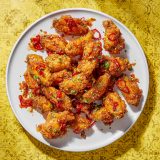You can travel to Paris for croissants (hard to find a good one), classic bistro food (leeks vinaigrette, stuffed cabbage or a frisée salad) or a baguette. Or, if you are more adventurous, you can go to Paris for a great bánh mì sandwich or a Cambodian rice bowl. That is exactly what I did on a recent trip, tracking down small eateries that offer fresh ideas from around the world. (If you go, I strongly suggest staying near the Jardin du Luxembourg. It’s quiet, bucolic and a great place for people-watching, plus the Louvre and Notre-Dame are both walkable.)
One of my favorite places is Coupi Bar, which is southeast of Montparnasse in the 13th arrondissement—a bit of a hike from the center of Paris and the trendy destinations of the 6th but easy to get to using the Métro.
Coupi Bar is small and well-known for its bánh mì sandwiches—the bread is homemade, as is the five-spice pork belly—but their menu has plenty of other offerings, from kimchi fries to piri piri chicken to steamed Asian buns. What I did not expect were chef Stéphane Ung’s Vietnamese chicken wings, which were, for my money, a big step up from the classic American version. (You should also visit Nonette, another bánh mì—and doughnut—shop run by chef Khánh-Ly Huynh.)
The first step, after trimming the wings (the wingtips are removed and the remaining wing is split at the joint, making two separate pieces), is to coat them in potato starch and fry them. Step two is to stir-fry them in a small wok along with fish sauce, Thai chilies, sugar, lemon grass, turmeric and shallots. Finally, they’re sprinkled with cilantro to serve. It’s bold; it’s bright; it’s a fresh makeover for classic chicken wings.
Here at Milk Street, we didn’t change much about the original recipe. We did include garlic and lime juice, the latter a common partner with fish sauce, and we used a skillet to finish the wings rather than a wok (which is traditional but not essential).
The only tricky part of this recipe is to reduce the sauce to the correct consistency before adding the wings; too thin or too thick, and it will not coat the wings properly. A good visual key is this: Once large bubbles form over the surface, it is properly reduced.
So, when in Paris, you might go traditional for dinner, but lunch should be a global free-for-all. It’s short money and long on flavor.
For Crispier Wings, Use Potato Starch
The key to ultra-crispy chicken wings—so crispy, they retain a crackly crunch even after being doused in sauce—is surprisingly simple: starch.
It turns out, starch is an effective barrier to moisture, which too often is the undoing of fried foods. When you coat chicken wings in starch before frying, the starch granules absorb any surface moisture on the meat. When then subjected to sizzling-hot oil, the moistened starches gelatinize, forming a gel-like network that hardens into a porous, brittle structure when cooled. This keeps the chicken moist and tender inside while the exterior stays crunchy.
Cornstarch and flour are the most common starches used for deep-frying. But at Coupi Bar, chef Stéphane Ung prefers potato starch—and for good reason. Potato starch granules are notably larger than cornstarch granules. Because of its smaller size, cornstarch particles gelatinize more quickly when fried. And the way this gel network traps moisture makes it harder for evaporation to occur.
By contrast, the larger potato starch particles gel less readily, offering moisture more of a chance to escape during frying. This produces a crunchier coating. Additionally, potato starch is less prone to retrogradation
(a process that causes starch to lose its crunch over time), so its crispiness lasts longer.








